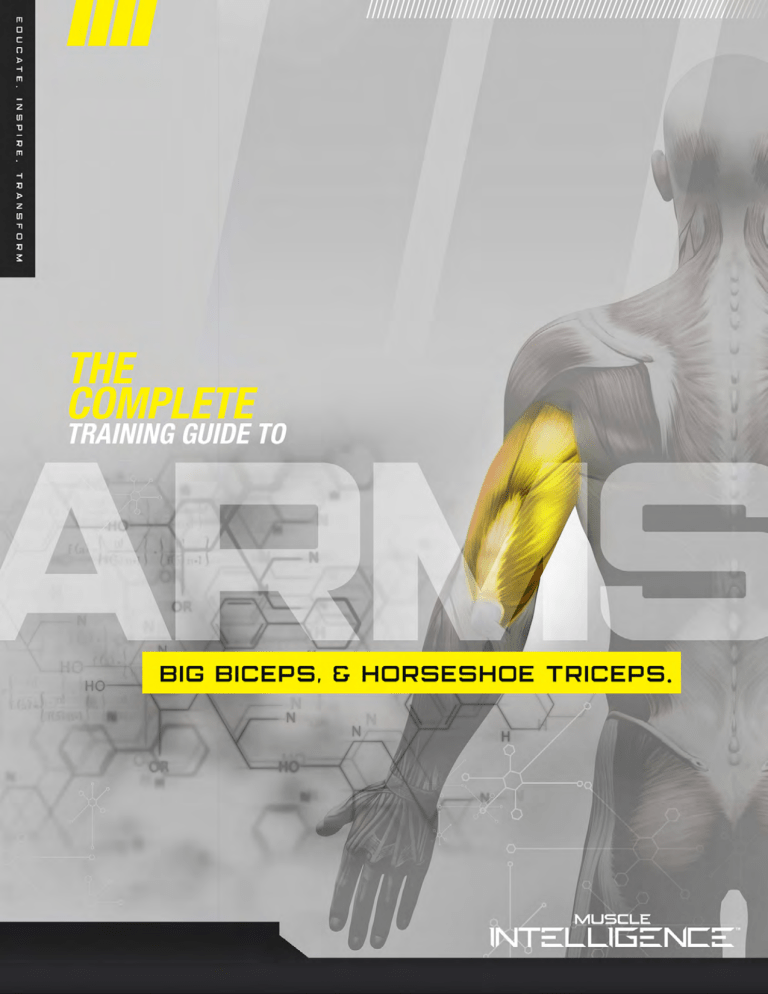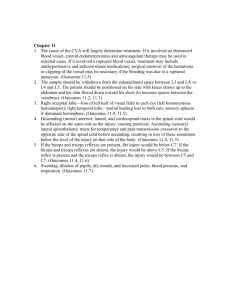
BIG BICEPS, & HORSESHOE TRICEPS T h e C o m p l e t e t r a i n i n g G u i d e t o A r m s BIG BICEPS, & HORSESHOE TRICEPS Learn the keys to optimize every minute of your workout to build massive biceps and triceps, in a fraction of the time while never hurting your elbows or shoulders again. T h e C o m p l e t e t r a i n i n g G u i d e t o A r m s BIG BICEPS, & HORSESHOE TRICEPS When it comes to arm training, I spent years beating my head against the wall wondering why all the information that I was reading from the top books, magazines and top athletes just wasn’t working. I thought it was me. I must have bad genetics. I followed all the common tips and tricks: More weight, more volume, more reps, less reps, more sets, more frequency, compound exercises. My arms grew a little bit, but more than anything I got sore joints and a lot of frustration. Many people are sold on the idea that the key is to manipulate the programming variables like reps, sets, volume, load, frequency, and density. More weight, more reps, more frequency, compound movements, etc. While I don’t think that is incorrect, it’s missing the most important piece of the puzzle. The thing that absolutely must happen before any of these variables can matter. The fact that not all reps are created equal, and not all people are created equal. I know this sounds obvious, but yet no one has taken the time to explain individual differences, and how to train to make the most of your training for your body. You and I are built very differently. How could anyone reason that ANY exercise done by two completely different people could yield the same result? The exact same exercise, done by two different people will apply forces against their body differently. One person can do an exercise, and immediately start to see results. Another person can do the exact same exercise with seemingly “good form” and get little to no results. THIS HAS ABSOLUTELY NOTHING TO DO WITH YOUR ABILITY TO BUILD MUSCLE. It simply has to do with how you fit into certain exercises, machines, and how your body decides it wants to distribute the load from the weight you just picked up based on a few easy to understand variables. T h e C o m p l e t e t r a i n i n g G u i d e t o A r m s BIG BICEPS, & HORSESHOE TRICEPS Consider this example: You’re going to bench press 100lbs. There is a very particular number of muscles that can assist in completing that movement. It’s never just one. The Pecs, Delts, Triceps, Biceps, Serratus, and Lats can all contribute to moving the load. The ideal scenario is to have the pec do 100% of the work and therefore the pecs are lifting 100lbs. THAT’S NOT POSSIBLE. Our job is to get as close to this ideal scenario of allowing the pecs to do as much work as possible by manipulating the position of our body (or SETUP) to advantage the muscle were trying to work, and disadvantage the other muscles. Someone may be able to get the pecs to do 70% of the work over the entire length of a set and never lose that amount of tension in the pec. For example 70lbs x 30 seconds. Their training partner may only get the pec to do 30% while other muscles work way more, and that may only be over a very small percentage of the rep in the mid ASK YOURSELF THIS QUESTION: range. 30lbs x 10 seconds. When you pick up a weight, what muscles are actually doing the EVEN THOUGH THE WEIGHT ON work? THE BAR (100LBS) IS THE SAME. Is the muscle you’re attempting to challenge taking the tension through every inch of every rep? With me? If you’re not with me, go back and read that again. It’s vital to your understanding of all training, and what needs to happen to grow. At the bottom: What is working most? Can I make it harder for this muscle? Am I resting? Here it is again in application: In the middle: What is working most? Can I make it harder for this muscle? Am I resting? One person can do a biceps curl, and their arms take a large percentage of the tension, over a maximum amount of every rep and grow. Another person can do the same exercise, with what may seem like “good form”, other muscles take over, they get sore joints, and no muscle growth. This DOESN’T mean that you can’t build muscle. All this means, is that when you pick up that weight, you must first learn the skill of placing the tension from the weight directly into the working muscle and sustaining it there over every inch of every rep. T h e C o m p l e t e t r a i n i n g G u i d e At the top: What is working most? Can I make it harder for this muscle? Am I resting? If you can’t say with 100% certainty that the muscle you’re training is in fact taking the majority of the tension, you’re wasting time, not getting maximum results, creating bad habits that are harder to break the longer you do them, and contributing to injuries and sore joints. t o A r m s BIG BICEPS, & HORSESHOE TRICEPS MORE, IS NOT THE GOAL. Some people love to get on the “hard work” bandwagon, and I completely agree. What they fail to recognize is that training your muscles with intelligence is by definition MUCH harder than conventional methods of lifting weights. If you read the bench press example above, you understand exactly what I mean. Just because I’m lifting more weight, does not mean my muscles are working harder, and does not mean I’m working harder. Actually it’s the exact opposite. We are taught that hard work is the key to success, and it absolutely is. But imagine owning a sales business and working really hard cleaning the floors and bathrooms, while neglecting the most important aspect of your business… sales. It’s not wrong to clean, it’s just not going to get you the results you’re after. It’s time to shift your focus to doing the things that get you the greatest ROI (return on investment). Just like running faster and faster in the wrong direction isn’t going to get you where you want to go. Doing more and more of the wrong thing, isn’t going to get you a different result. The goal shouldn’t be to do more and more, the goal should be to get better and better. Your body is designed to make things easy. If you’re not training consciously (being present, thinking, focused on challenging muscles), you’re not building as much muscle as you could be. T h e C o m p l e t e t r a i n i n g G u i d e t o A r m s BIG BICEPS, & HORSESHOE TRICEPS OLD SCHOOL VS. NEW SCHOOL Some people can pick up a weight and contract 60-70% of their muscle fibres. Others will contract 20-30%. • Who’s going to get results faster? • Who’s going to burn more calories? • Who’s going to get the most work done in less time? If you’re going to invest your time going to the gym, you should make sure you’re getting something out of it. The good news is that you do not have poor genetics. You just haven’t learned the keys to maximizing muscle for YOUR body. You are unique. You need to select exercises, and setup for your body. If you’re suffering from a “weak” body part, or looking to build as much muscle as possible, the foundation of all future progress is the SKILL of placing as much tension as possible through a muscle. T h e C o m p l e t e t r a i n i n g G u i d e t o A r m s BIG BICEPS, & HORSESHOE TRICEPS When I say tension, most people’s mind goes straight to thinking about more weight. More weight does not always mean more tension in a muscle. Our bodies are designed to make things easy, and distribute tension to as many muscles as possible, never to isolate muscles. The largest muscle will take the greatest percentage of the weight, and smallest muscles will take the least amount of weight. Therefore, large and strong body parts keep getting stronger while the weak parts stay weak. This gradient between the strong and weak muscles will inhibit growth overall (you’re only as strong as your weakest link), and lead to injuries. So, you’re here, you’re way ahead of the curve and you’re likely already doing 90% of the things right. But it’s in that 10% that all the progress lives. Let’s get to work on getting you dialed in, and building muscle with way less effort than you ever thought was possible. HERE ARE SOME GENERAL THINGS I DON’T WANT YOU TO DO: • Train like everyone else. • Thinking more is better. It’s not. Better is better. • Focus on moving weight and completing sets and reps. • Mindlessly lift heavy. • Go back to the same stuff you’ve been doing. • Avoid doing something because it doesn’t feel good….. yet. • Get sloppy in your training so you can pad your ego. • Be attached to old school bro-splits like once a week per body part nonsense. • Think lifting heavy is the key to growth (it’s not). • Think that free weight movements are better than machines, or cables. (they typically are not). T h e C o m p l e t e t r a i n i n g G u i d e t o A r m s BIG BICEPS, & HORSESHOE TRICEPS THE KEYS TO OPTIMIZED ARM TRAINING FOR MAXIMUM GROWTH: The beauty of the biceps and triceps is that they are mirror images of one another. A fully lengthened triceps, is a fully shortened biceps. A fully lengthened biceps, is a fully shortened triceps. The key points will overlap. What holds for one, will also hold for the other. (*The only exception to that rule is with supination (turning the palm up) of the biceps. It will shorten the biceps, but will not affect the triceps. NOTE: supination is an action of the forearm and no movement should happen at the shoulder or upper arm). • Train at multiple degrees of shoulder flexion/ • Perfect form FIRST. Heavy weights second. extension. This impacts the long head of the • Choose exercises that allow for maximum stability biceps most (shoulder flexion-elbow high, and maximum load within the realm of perfect form. shoulder extension- shoulder extended behind • Control is key. Can you stop at any point of the you, and everywhere in between). exercise and change directions on command? • Lock your entire body in stone. Stability is the key to strength and hard contractions. • Learn to set your body up correctly so that the arm (biceps/triceps) is in a straight line relative to the resistance (no internal/external rotation at the shoulder happens during a movement). • Stabilize the shoulder joint. An unstable shoulder will be the most common reason you fail on a set. • If it moves, it’s failing. • Overload supination of the biceps by supination and pronation during sets of DB curls, and with offset grip DB curls. T h e C o m p l e t e t r a i n i n g • Muscles are weakest in the shortest position. Strongest in the lengthened and the mid-range positions. Choose resistance that matches this as often as possible. • Spend time where you’re weak. • Heavy loads will not always be limited by your muscle strength, but often by your shoulder stability. • Progress from internally stabilized to externally stabilized exercises within a workout. (Ex. Standing DB curl requires you to stabilize. DB preacher curl uses the bench to stabilize). • A “full range of motion” does not have to happen in every set or exercise, as long as its happening within every workout. G u i d e t o A r m s BIG BICEPS, & HORSESHOE TRICEPS REMEMBER THIS: S.S.I. SETUP Setup is the key to ensure the muscle you’re trying to work is in fact the prime mover. STABILIZE You body will turn down contractions if it senses any instability. Stability is the key to hard contractions. Lock your body in stone. INITIATE Make sure the muscle you’re working is the muscle that initiates the movement from the stretched position on every rep. T h e C o m p l e t e t r a i n i n g G u i d e t o A r m s BIG BICEPS, & HORSESHOE TRICEPS BIGGEST MISTAKES IN ARM TRAINING: • Bad exercise selection. • Unnecessarily moving the shoulder during an exercise (HINT: do not move the shoulder at all). • Not understanding how to set up your body relative to the resistance to maximize work to the muscle and not destroy your joints. (This is key! The body, and forces applied on it during exercise work in straight lines). • The elbow is a hinge joint. The bicep flexes the hinge, the triceps extends the hinge. Think about that and see previous point. • Poor shoulder stability/allowing the shoulder to come up (inability to adequately depress shoulder). • Poor posture (rounded mid back will kill stability and gains). • Lack of trunk/core stability. • Poor shoulder mobility (lacking external rotation- often due to slouched shoulders and rounded back) • Not challenging every inch of the range of motion. Here are the Core Exercises to Master for Arms: BICEPS [4] • Standing Dumbbell Curl • Preacher Dumbbell Curl • High Cable Curl • Incline Cable Curl TRICEPS [5] • Two-Arm Triceps Pushdown (facing cable machine/facing away from machine) • Single Arm Cable Pushdown (facing machine/facing away from machine cross body) • Single Arm Overhead Cable Extension • Single Arm Dumbbell Floor Extensions • Dip. (Machine or free weight). T h e C o m p l e t e t r a i n i n g G u i d e Videos for these exercises, and all the Core 40 exercises are in MI40 Nation. Head there now and watch them. t o A r m s BIG BICEPS, & HORSESHOE TRICEPS HOW MUCH, HOW OFTEN? How much, and how often is a question that is dependent on a number of different individual variables: SKILL How well do you execute this exercise? The better you train with a Muscle IntelligenceTM approach and without extraneous movement (swinging), the more direct tension you send through a muscle. More tension means the muscle will receive more damage and direct fatigue, and therefore need more time to recover. The muscular system doesn’t need as long as the nervous system does to recover, so when training with intelligence, you can really expect to feel better physically and mentally even when training more often and with higher volume. Neurologically taxing workouts (heavy workouts or mindless lifting) tend to cause more overall fatigue to the body and mind. Doing this strategically, or when the goal is to get strong, is a necessary part of the training adaptation. However, this type of neurologically taxing training is not the best way to build muscle. Think of training like this: You can only ever have one “choke point”. One system that is challenged most. If your goal is to build muscle, this has to be the muscular system more often than not. If your choke point is the nervous system, or metabolic system (your ability to produce energy), those systems will be taxed the most and therefore they will be the one to adapt. Ensure the muscular system is most often the one being taxed by not training to complete failure every set (let your perfect execution be your guide), and by measuring rest periods to allow enough time for the body to replenish energy substrates. T h e C o m p l e t e RECOVERABILITY Your ability to recover from your training is dependent on: nutrition, sleep, stress, environment, perception of effort, history, aerobic fitness, mitochondrial health. If any of these are not optimized, your recovery will vary. Make a list, assess yourself subjectively. TYPE OF TRAINING STIMULUS. Neurological, hypertrophy and metabolic style training will all impact your recovery time differently and therefore how often you should train. In general, the nervous system will take 48-72 hours, the muscular system will 24-72 hours*, and the metabolic system can take much less time. *NOTE: the more time spent eccentrically in training, the more time you need for recovery of the muscular system. VOLUME & FREQUENCY Volume and Frequency is inversely proportional. As one goes up the other goes down. Training a body part more often (every 1-3 day), means the volume in each session must go down. This is a great place to begin for someone looking to improve the skill and contractile ability within a muscle. In general, the faster you want to learn a skill, the more often you should do it. Training with a lot of volume in a workout, and the muscle needs longer to recover. Typically 48-72 hours between workouts, or more for the muscular system to recover. t r a i n i n g G u i d e t o A r m s BIG BICEPS, & HORSESHOE TRICEPS MINDSET • You must walk into the gym with absolute confidence. • Prepare your mind. Create an anchor of the person you are in the gym. • Become a Jedi. Laser focused effort. • Skill mastery must precede hard work. • You must know your plan, and execute with relentless effort. • Focused savagery during sets. • Equanimity (Calm, undisturbed mind ) between sets. • No anger, no anxiety, no fear. • Absolute certainty that you will accomplish every rep with perfection and aggression. • Always do more than is expected of you. • You can do so much more than you believe. Your mind will always limit you. •N ever let anyone beat you. Find their weakness, and exploit it. • Every single workout is an opportunity to create your greatest self, or retreat into weakness and defeat. • You must feel the fear, and smile, knowing you’re becoming a better version of yourself. • Seek to challenge your muscles, not to pad your ego. • Challenge your weaknesses, don’t simply pursue your strengths. • Seek to challenge all properties of the muscle. Strength, Endurance, Volume. No weaknesses. • Skill of exercise is the foundation of all growth. • Your mind is your greatest ally, or your biggest enemy. Train it. • Never quit. Don’t EVER be a victim. Choose your words. Choose your company. Choose your body. Choose your mindset. Create your life. • Never quit. T h e AND THE BIGGEST LESSON OF ALL: C o m p l e t e t r a i n i n g G u i d e t o A r m s BIG BICEPS, & HORSESHOE TRICEPS CONCLUSION: Now that you’re well versed at the keys to develop this and any body part, the next step is implementation and progression. How to Proceed and Succeed: START NOW! Do not wait to implement these tips tricks and cues. READ one tip a day and master it. WATCH one video a day and practice practice practice. NEVER revert to poor habits. Your ego will be a worthy opponent. FOLLOW up with one of our intelligently designed workout programs. They are designed to increase skill acquisition and progress maximally without plateaus. T h e C o m p l e t e t r a i n i n g G u i d e t o A r m s



